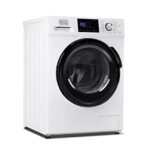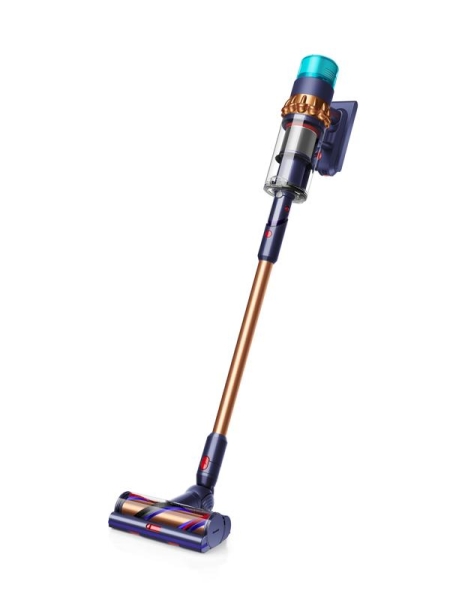
Dyson Gen5detect Absolute Vacuum
Cord length: N/A | Battery life: 70 minutes | Weight: 7.7 pounds | Capacity: 0.2 gallon | Special features: Built-in crevice tool | Warranty: Limited 2-year warranty | Attachments: Hair screw tool, Digital Motorbar cleaner head, Fluffy Optic cleaner head, wall dock, combination tool
Best for:
- Anyone who appreciates the latest in vacuum technology
- Those who have both carpet and bare floors
- Homes with pets
Skip if:
- You’re on a budget
- You need more than 70 minutes of battery life
The Dyson Gen5detect Absolute Vacuum is an upgraded version of the Dyson V15 Detect, a cordless model that Forbes Vetted has previously picked as the best cordless stick vacuum, best Dyson vacuum overall and best vacuum for pet hair. In my testing, I found that the Gen5detect Absolute not only delivered superior performance—easily removing debris from low-pile carpet, high-pile carpet and hardwood flooring—it also was a real pleasure to use. At 7.7 pounds, it’s slightly heavier than some of the other cordless models I tested, but it’s still easy to maneuver and move between floors. It has the longest battery life of any cordless stick vacuum I tried, topping out at 70 minutes where comparable models could do only 40 minutes (the second-longest battery life was my best cordless pick, the Dyson V11, at up to 60 minutes of runtime).
Unlike the other three stick vacuums I tried, the Gen5detect is equipped with a button to turn the vacuum on and off rather than a trigger, a nice feature that prevented my hand from cramping up when using it for prolonged periods. It also has a crevice tool built into the vacuum, nested inside the tube that connects the motor and the vacuum head. That means converting it into a handheld vacuum is a snap—no need to dig around to locate the other attachment you may not have immediately on hand. The Gen5detect Absolute comes with both a Digital Motorbar—a more standard Dyson vacuum head—and a Fluffy Optic head, an attachment that uses a precisely angled arc of green light to illuminate dirt and pet hair.
That Fluffy Optic head is where things get really fun: It identifies stray pet hairs and specks of dust that are invisible to the naked eye. I found using it to be slightly addictive—I would sweep over rooms I had previously vacuumed and find all manner of stray cat hairs and dust. The only major drawback is that on older hardwood floors, like I have in my house, the vacuum often illuminated flaws in the flooring that looked like dirt, but were just the grain of the wood. The vacuum’s screen also displays roughly how many of each size particle you’re vacuuming up. That feature plus the built-in HEPA filter are great for people looking to target allergens in their home—it makes cleaning feel like a video game rather than a chore. Maintenance of the vacuum is easy—the canister of debris empties directly into the trash with a sliding button. It took a little getting used to the exact mechanisms, but once I did it a couple of times, it was no problem.
I was hesitant to name a cordless vacuum as my best vacuum for most people because I worried that the battery life wouldn’t be long enough for a whole-house vacuuming. But to my pleasant surprise, my multilevel, 2,832-square-foot Philadelphia rowhouse presented no problem with the Gen5detect’s battery life, and moving the vacuum up and down the stairs was much easier than lugging the upright model I had used previously. The battery life didn’t give out, and I didn’t have to stop to empty the bin until I was fully done vacuuming. (If you want to learn more about why this is a great vacuum for most homes, check out my full review of the Dyson Gen5detect Absolute Vacuum.)
The 2024 Forbes Vetted Best Product Awards are here: Explore our 150 top-recommended items across categories after extensive research and testing.
Best Value Vacuum
A Reliable Upright Bagged Vacuum With Ample Cord Length
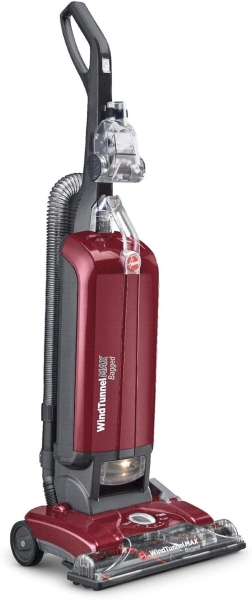
Hoover WindTunnel Max Bagged Upright Vacuum Cleaner
Cord length: 30 feet | Weight: 18.4 pounds | Capacity: 0.77 gallon | Special features: Floor height adjustment | Warranty: Limited 2-year warranty | Attachments: Telescoping extension wand, 12-inch crevice tool, upholstery/dusting brush, air-powered hand tool
Best for:
- Large homes with fewer floors
- Those who prefer plug-in models
- Homes with bare floors or low-pile carpet
- Anyone on a budget
Skip if:
- You want a lighter vacuum
- You have a lot of stairs
- You have high-pile carpet
If you’re looking for a budget-friendly vacuum, I recommend the Hoover WindTunnel T-Series Max Bagged Upright Vacuum. This dependable upright model efficiently removes debris from both carpet and bare flooring and comes in at under $200. Since the Hoover WindTunnel is a plug-in vacuum, I didn’t have to worry about running out of battery or constantly changing outlets, thanks to its 30-foot-long cord. Additionally, the Hoover has a convenient adjustment feature that allows you to customize the vacuum cleaner for different floor types or carpet heights, offering seven different increments to make transitioning from bare floor to carpet much smoother. I’ve found this feature particularly useful for effectively cleaning both the bare floors in my house and thoroughly removing grime from low-pile rugs.
Despite its strengths, the Hoover WindTunnel may not be suitable for every home. It’s on the heavier side, which might not be ideal for multistory residences like my three-floor rowhouse. Furthermore, it requires more storage space compared to slim, cordless models, so if closet space is limited, you may want to explore other options. While the Hoover performed admirably in picking up scattered debris from low-pile carpet and bare flooring, it struggled slightly more with high-pile carpet.
As a bagged upright-style vacuum, you’ll need to keep bags on hand to use with the Hoover. This adds an extra expense for maintenance and long-term usage, but the bags are inexpensive—you can purchase them for about $1 apiece on Amazon—and relatively capacious at about 0.8 gallon, so you won’t need to change them frequently. The added hassle of stocking bags may be worthwhile if you have allergies, as emptying the Hoover simply involves disposing of the bag, rather than emptying a canister that could release dust and debris back into the air. While it lacks many fancy features, if you’re seeking a vacuum that performs its job effectively without breaking the bank, the Hoover WindTunnel T-Series Max Bagged Upright Vacuum is an excellent choice.
Best Vacuum For Pet Hair
A Functional, Versatile And Affordable Pick For Pet Parents

Shark NV352 Navigator Lift-Away Upright Vacuum
Cord length: 25 feet | Weight: 12.5 pounds | Capacity: 0.2 gallon | Special features: Brush-roll shut-off | Warranty: Limited 5-year warranty | Attachments: Upholstery tool, crevice tool
Best for:
- Larger homes
- Bare floors and low-pile carpet
- Pet owners
Skip if:
- You prefer a cordless model
- You prefer a lighter model
- You prefer a bagged vacuum
I have no lack of pet hair in my house. With three cats roaming around, cleaning away fur from couches, chairs, floors and other surfaces is a constant battle, so I know firsthand how frustrating it can be. Many vacuum heads will get tangled or clogged with pet fur, or simply not lift enough of it up during a first pass, leading you to have to vacuum the same area multiple times. But the Shark NV352 Navigator Lift-Away Upright Vacuum—also our best value pick in our best vacuums for pet hair story—was one of the best upright vacuums I tried. It excelled at removing even the most stubborn patches of shed pet hair.
In my house, cat hair tends to accumulate in corners, under the beds and on a velvet chair I bought in a fit of optimism. The Shark Navigator handled all of those spots with ease, thanks in part to a neat feature that lets you easily convert the machine into a portable canister-style vacuum, removing the debris pod and suction arm from the vacuum head. I could be cruising along, vacuuming up debris from the floor, and notice a thicket of pet hair on a chair. Without missing a beat, I could then convert the vacuum into its pod form and pick it up to vacuum up cat hair from the upholstery. I found, in general, the potential to convert the vacuum allowed for easier access to nooks and crannies, as well as more efficient vacuuming of surfaces that are higher than floor height. Though my house doesn’t have a whole lot of drapery, it does sometimes have bugs, and I was able to suck up an offending spider from the ceiling midway through my clean.
The Shark Navigator also has an easy switch that allows you to adjust the vacuum to tackle different heights of floor—going from bare tile to high-pile carpet, say. The strong suction also easily handles pet hair that otherwise gets lost in the cracks between floorboards or the corners of the room—those dreaded little tumbleweeds that seem to collect, no matter what I do. I never had to stop to untangle built-up hair out of the vacuum, which can be a real pain when tackling pet hair. Some pet hair–focused vacuums have attached grooming tools that the Shark Navigator doesn’t have, but as my cats are not particularly interested in being approached by a vacuum, it wasn’t a problem for me. I also appreciated that the Shark Navigator has a generous warranty, giving you 5 years’ coverage in case of any mishaps. (If you want to learn more about why this is a great vacuum for tackling pet hair, check out our full review of the Shark NV352 Navigator Lift-Away Upright Vacuum.)
Best Canister Vacuum
A Capacious, Powerful Vacuum For Big Messes
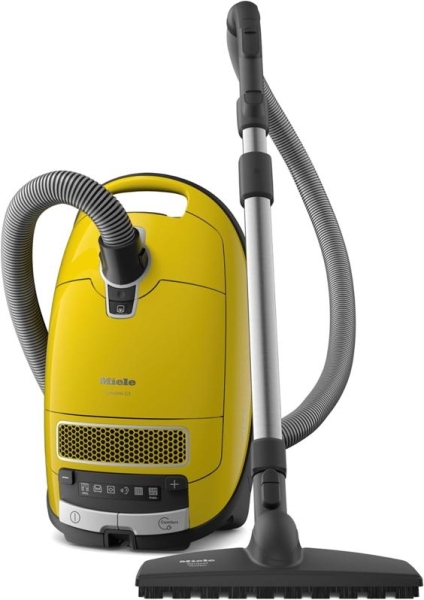
Miele Complete C3 Calima PowerLine
Cord length: 24 feet | Weight: 20 pounds | Capacity: 1.18 gallons | Special features: N/A | Warranty: Limited 5-year warranty | Attachments: Upholstery nozzle, crevice nozzle, dusting brush with synthetic bristles, parquet Twister Floorhead, Turbo Brush Floorhead
Best for:
- Large houses
- Big messes
- Cleaning drapes and hard-to-reach corners
- Anyone who appreciates serious suction power for high-pile carpets
Skip if:
- You’re on a budget
- You’d prefer a cordless or upright model
- You’d prefer a bagless model
The Miele Complete C3 Calima PowerLine, also highlighted in our best canister vacuums story, presents a lot of advantages. First, there’s no limit to the motor’s capacity, since it’s separate from the suction nozzle. Second, because the nozzles, motor and debris bin are separate, it’s much easier to deal with dirt that isn’t at the floor level. The Miele Complete C3 is one of the heavier models I tested, but because the nozzle and the canister were separate, bringing it up and down the stairs was less onerous than with an upright model. It performed excellently on bare floors and low-pile carpet, but I was particularly impressed at how much scattered debris it got out of a high-pile rug—a test that tripped up the Shark Stratos Cordless Vacuum and the Tineco Pure One S11 cordless models— thanks to a manual adjustment setting that allows you to choose what kind of carpet the machine is cleaning, rather than the automated controls on upright models.
Though the cord length is shorter than the upright models I tried, I never had trouble with it getting snagged on a corner or stopping short. It also has a huge debris bin, which means that you won’t have to stop to empty it midway through cleaning. Like the Hoover WindTunnel T-Series Max Bagged Upright Vacuum, the Miele Complete C3 requires you to swap out bags rather than simply empty the canister, something that could be either an advantage or disadvantage, depending on your personal preferences. Canister vacuums in general are great for cleaning surfaces that are elevated because you move the vacuum head separately from the vacuum motor, so if you have a lot of upholstery to clean, or want to seamlessly switch between cleaning the floors and the corners of your ceiling, they’re the way to go.
Miele makes models that aren’t as expensive, so if you like the idea of a canister vacuum but want something more budget-friendly, the Miele Classic C1 Pure Suction PowerLine, which retails for under $350, is a solid option. I eliminated it because it didn’t perform as well as the Miele Complete C3, picking up less debris on both the high-pile and low-pile carpet. But if you’re looking for a canister that works well and is in a lower price range, it’s a solid model.
Like the Hoover WindTunnel T-Series Max Bagged Upright Vacuum, this model requires bags, which is a consideration for long-term upkeep and care, but they’re inexpensive and easily available on Amazon. (Interested in learning more about this canister vacuum? Check out my detailed Miele Complete C3 Calima PowerLine review.)
Best Robot Vacuum
A Smart, Sleek, Self-Emptying Robot Vacuum
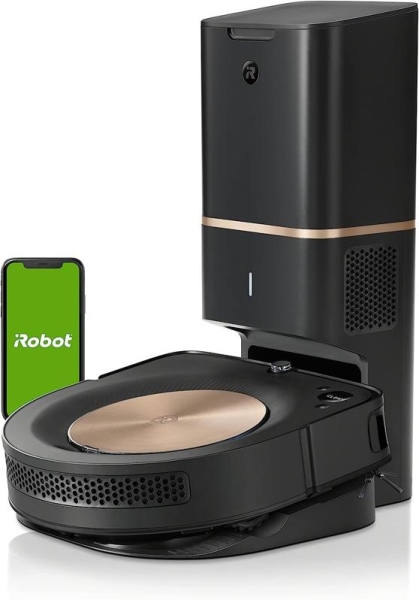
iRobot Roomba S9+ Self-Emptying Robot Vacuum
Cord length: N/A | Battery life: 120 minutes | Weight: 8.15 pounds | Capacity: 0.15 gallon | Special features: Self-emptying, smart-mapping | Warranty: Limited 1-year warranty | Attachments: N/A
Best for:
- Houses with open floor plans
- Larger homes
- Automatically cleaning corners and nooks where dirt accumulates
Skip if:
- You’re on a budget
- You tend to have a lot of things on the floor
- You’re looking for a manual approach to cleaning
A robot vacuum should make your life easier, not be another device you need to tend to when it becomes clogged, trips over cords or skips cleaning difficult-to-get-to places. That’s why the iRobot Roomba S9+ Self-Emptying Robot Vacuum, the top pick in our best robot vacuums roundup, is my pick for the best robot vacuum. This model has a D-ring shape that effectively cleans corners and nooks where debris tends to accumulate. In my testing, the Roomba S9+ did the best job cleaning every size of debris from every surface I tested, compared to other robot models. The self-emptying feature cuts down on maintenance and means that the relatively meager capacity of the debris bin doesn’t limit the robot vacuum’s effectiveness.
Robot vacuums are excellent if you have a larger home that doesn’t have many stairs, or if you have an open floor plan. They aren’t that great if you tend to have a lot of things hanging out on the floor, as I discovered when testing robot vacuums in a room with several piles of books. But overall, the Roomba S9+ avoided obstacles with ease and had an app and interface that were intuitive to use. Of the four robot vacuums I tested out, the Roomba S9+ had the best navigation technology, avoiding cords, pet toys and chair legs without trouble and without me having to intercede to gently push the vacuum on its way. The automatic emptying technology meant that I only had to worry about cleaning out the bin on trash day, rather than every time the vacuum operated. But the self-emptying function was startlingly loud, and it took me a while to get used to.
It does take a fair bit of time for the vacuum to clean, particularly if you have a lot of square footage. The Roomba S9+ took about two hours to clean 750 square feet, which means that it will likely be cleaning a good bit of the day if you have a larger home and set it to clean the floors daily. If that’s not a concern, it’s a great option for an automatic, low-maintenance, high-powered vacuum to give a regular cleaning to your space.
Best Handheld Vacuum
An Agile Vacuum For Quick Messes And Hard-To-Reach Spots
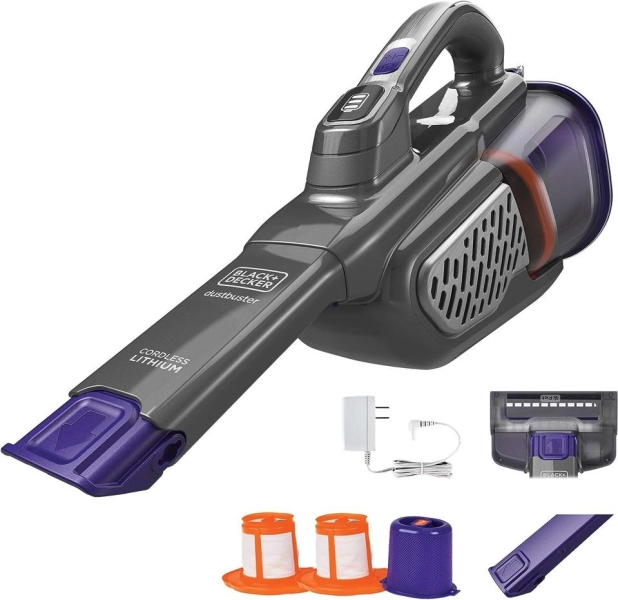
Black+Decker Max Dustbuster AdvancedClean Cordless Pet Hand Vacuum
Cord length: N/A | Battery life: 20 minutes | Weight: 4.3 pounds | Capacity: 0.2 gallon | Special features: N/A | Warranty: Limited 3-year warranty | Attachments: Crevice tool, pet-hair motor head
Best for:
- Homes with pets
- Surface cleaning
- Anyone on a budget
Skip if:
- You need longer battery life in a vacuum
- You’d like a handheld vac with a slimmer profiler
For the car, small messes or times when getting out the full vacuum seems like overkill, a handheld vacuum is the way to go. Handheld vacuums come in a variety of sizes, including very slim, very light versions that can easily fit in the back of a car or tuck into a corner of a room unobtrusively. The Black+DeckerMax Dustbuster AdvancedClean Cordless Pet Hand Vacuum isn’t that—it has a larger body than several of the hand vacuums I tried—but its superior suction and pet-hair detangling tool made up for it. The bin capacity is 0.2 gallon, the largest of any of the handheld vacuums that I tested, which meant that I could vacuum up a whole mess or tackle the back seat of my car without having to stop to empty the debris canister multiple times.
The powerful suction managed to get the most debris—Cheerios, coffee grounds and baking soda—off all the surfaces. It struggled a bit with high-pile carpet, but I found that every handheld model on my list did as well—it seems to just be a surface where you need a machine with a bit more oomph to thoroughly clean it. But I was particularly impressed by how well the Black+Decker AdvancedClean managed to get smaller particles of coffee grounds out of the low-pile carpet and the little crevices of my hardwood floors. It’s great even if you don’t have pets, but if you do, the machine comes with a clever pet-hair motor-head attachment that makes the thing look like a miniature version of an upright vacuum head. The attachment quickly and effectively got rid of lingering pet hair when I needed to give the couch a quick once-over before guests arrived.
While the battery lasts only 20 minutes, that’s more than double some of the other models on the market (one model I tested worked for only nine minutes before needing a full recharge), and more than enough time to give an entire room a quick spot clean. A handheld vacuum probably won’t ever be enough to cover all your vacuuming needs, but it’s an incredibly convenient add-on tool to have in your cleaning arsenal.
Best Cordless Vacuum
An Unobtrusive, Powerful And Easy-To-Maneuver Vacuum
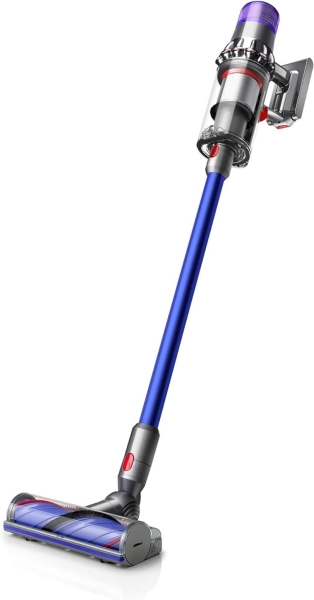
Dyson V11 Vacuum
Cord length: N/A | Battery life: 60 minutes | Weight: 6.61 pounds | Capacity: 0.2 gallon | Special features: LCD screen | Warranty: Limited 2-year warranty | Attachments: Crevice tool, hair screw tool, combination tool
Best for:
- Smaller homes
- Surface cleaning
- Bare floors and low-pile carpet
- Pet owners
Skip if:
- You’re on a budget
- You have a larger home
- You prefer a corded model
Though I named the Dyson Gen5detect Absolute Vacuum, a cordless vacuum, as my overall best pick, I’m conscious, of course, that not everyone can or wants to spend almost $1,000 on a vacuum. If you want a cordless vacuum that works well; can tackle pet hair, bare floors and carpet easily; and has a sleek profile but retails for several hundred dollars less than my winning pick, I recommend the Dyson V11 Vacuum. Though the V11 doesn’t have the same bells and whistles as my top pick—no optic head with a video game–like green glow—it still tackles messes handily. At 6.61 pounds, it’s even lighter than the Gen5detect, a small difference that can make a big impact. I found that bringing the V11 up and down the three flights of stairs in my house was slightly easier than the Gen5detect, and that maneuvering it around tight spaces was also just a hair smoother.
Like the Gen5detect, the V11 has an LCD screen at the top of the model. Whereas the Gen5detect displays how many of each size particle you pick up, the V11 tracks battery life and how much time you have left until the machine needs a recharge. The screen will let you know if the machine needs maintenance—if the filter needs to be replaced or some debris is caught in the vacuum head that needs removing. During one of my tests, vacuuming up Cheerios from a high-pile carpet, I accidentally scattered more Cheerios than I meant to, and the machine became temporarily stuck trying to vacuum up a giant pile of cereal. The machine’s screen clearly showed me where the clog was, and I was able to easily deconstruct the machine, pull out the offending bits and keep vacuuming. It saved me the huge hassle of having to go through each part of the vacuum to look for what was gumming up the works.
Though the V11 has slightly less battery life than the Gen5detect—topping out at 60 minutes, rather than 70—it was still one of the longest battery lives of the cordless machines I tested. (The Tineco Pure One S11, for example, has a maximum of 40 minutes.) It also performed well in my debris tests, ably sucking up baking soda, coffee grounds and Cheerios from surfaces with ease, aside from the one incident. I was able to do a full maintenance sweep of the three floors of my house without it needing a recharge. The V11 has a trigger switch to turn the vacuum on and off, rather than the handy button the Gen5detect uses, which can get tiresome to hold down, but after a while I got used to it.
Other Vacuums I Tested
I tested nine other products that didn’t make the cut:
Shark Stratos Cordless Vacuum: This vacuum is clearly a competitor to the Dyson empire, with a flexible frame and “Clean Sense IQ” technology, meaning that the vacuum automatically adjusts the power of its suction to whatever dirt it’s detecting. It has up to 60 minutes of battery life, which ranked among the longest of the stick models I tried, and I liked the flexible design. In my tests, however, it proved less powerful at picking up dirt and debris than other models, including the Shark NV352 Navigator Lift-Away Upright Vacuum.
Miele Classic C1 Pure Suction PowerLine: If you like the idea of a canister vacuum but aren’t interested in spending more than $500, the Miele Classic C1 might be for you. It has all the strengths of a canister vacuum—you move the head, not the body—at a much lower price point. When compared head to head with the Miele Complete C3 Calima PowerLine, however, I found it was more awkward to maneuver and had less powerful suction.
Dyson Ball Animal 3: This powerful upright model includes a fun pet-grooming tool, and performed pretty well in my testing. It was nudged out of contention by the Dyson Gen5detect Absolute Vacuum in the best vacuum overall category, and it’s much more expensive than my top pet-hair pick, the Shark NV352 Navigator Lift-Away Upright Vacuum. Plus it was more difficult to use to pick up hair from surfaces above ground level.
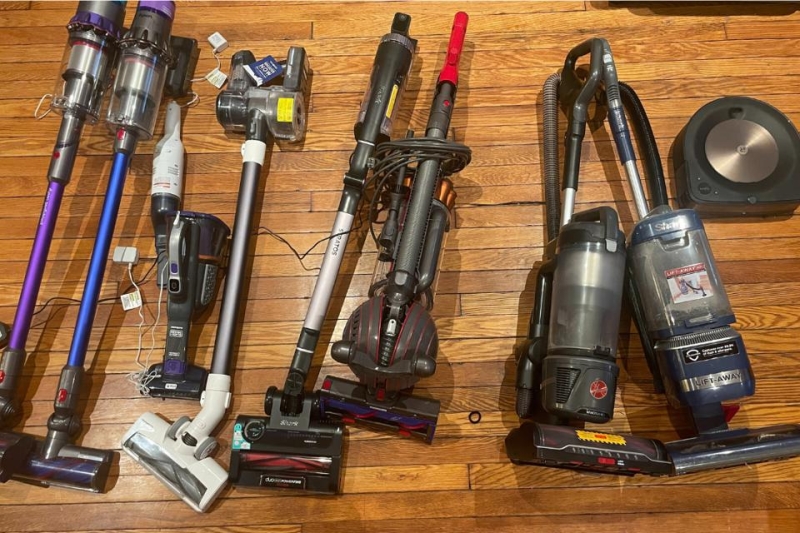
I tested 16 models over the course of 2 months to find the best vacuums on the market for most homes.
Black+Decker Dustbuster QuickClean Cordless Handheld Vacuum: This is a handy handheld vacuum, but it has less battery life than my best handheld vacuum pick, the Black+Decker 20V Max Dustbuster AdvancedClean Cordless Pet Hand Vacuum, and it doesn’t pick up as much debris either.
Black+Decker AdvancedClean+ Slim Cordless Hand Vacuum: This nifty hand vacuum has an incredibly sleek, small profile, which makes it great at attacking hard-to-reach places. It unfortunately has a pretty short battery life—just 14 minutes maximum—and a smaller debris bin than my best handheld vacuum pick.
Shark AI Ultra Self-Empty Robot Vacuum: This robot vacuum has self-emptying technology, like my top pick, which is a major plus. But the mapping technology behind it isn’t as sophisticated—I found that it kept bumping into obstacles that the other robot vacuums easily avoided, and more than once I had to stop testing to remove some tangle from the roller brush head.
iRobot Roomba J7 Robot Vacuum: This model performed well in my tests, picking up a good amount of debris and navigating most obstacles. It got beat out by the Roomba S9+ because of the winner’s D-ring shape, as opposed to the J7’s rounded one, a feature that allowed it to tackle more nooks and crannies.
iRobot Wi-Fi Connected Roomba I4+ Self-Emptying Robot Vacuum: This is a solid robot vacuum overall, backed by iRobot’s excellent user interface and mapping technology. But in a head-to-head battle with the other robot vacuums, it lagged a little, failing to pick up as much dirt and debris. It also has a standard round shape rather than the S9+’s D-ring shape, which meant it couldn’t always get into corners and crannies as effectively.
Tineco Pure One S11: Stick vacuums tend to be expensive, and I appreciated that this model was one that would fit into many more homes’ budgets than pricey Dysons. It’s easy to use, but the battery life is significantly less, topping out at 40 minutes, which means I wasn’t able to clean the entire house. It would be a good model for smaller homes or spot-cleaning a small space, like a dorm room or studio apartment.
How I Tested The Best Vacuums
To test the best vacuums, I dug into the many Forbes Vetted reviews of specific vacuum categories to look at how my predecessors had determined their winners. Though different models of vacuums excel at different tasks, all of them have a universal purpose: to remove dirt and debris. So I hit upon a series of tests for all the vacuums. I ordered a small high-pile carpet, a small low-pile carpet and linoleum tiles. I also bought a swatch of bare hardwood flooring to test in my house. On each of them, I scattered baking soda, coffee grounds and Cheerios, measuring out 20 grams of each category of debris before I scattered it. Then I vacuumed up the debris and weighed it to determine what percentage the vacuum had picked up.
Because I was considering so many different types of vacuums, all designed for different purposes, I also performed more general tests. I used each vacuum to clean my house, tackling the regular dirt and debris that got tracked indoors, minor kitchen spills and patches of cat hair or the cat litter my three pets had tracked outside their boxes. I took into account how much each vacuum weighed and how awkward it was to lug between floors.
I also noted if it had a large, clunky profile that would make it difficult to store in a small space, or a neat, sleek profile that could easily be hung on the wall. If the vacuum had a cord, I noted how the cord length affected the cleaning. If the model had a battery instead, I ran the vacuum at full power until it ran out of juice to see how well it did. I also took into account how easy each vacuum was to disassemble and reassemble, since many vacuums include attachments or other tools that require you to take the vacuum apart to use. I also noted how difficult it was to empty, and how frequently I needed to do that as the bins filled up.
For the robot vacuums, I took note of which app interface was easiest and how difficult it was to reroute the robots if they stumbled in their tracks, as well as how obtrusive they were while operating.
Finally, I considered what the experience of using the vacuum was like: Did it have features that meant it was difficult to maneuver or otherwise reach tight corners? Was it a vacuum I was likely to reach for when a mess occurred, or did it have stumbling blocks that meant getting it out and using it was more difficult? Those factors are trickier to quantify in hard data, but user experience is an important factor in vacuuming, since it’s a chore that needs doing regularly.
How To Pick A Vacuum
There is a wide range of vacuums out there, and each style has its strengths. Here’s what you’ll want to consider while shopping to make sure you bring home the best option for your cleaning needs.
Different kinds of vacuums excel at different surfaces. When choosing a vacuum, it’s smart to think about what surface you’ll be tackling: Do you mostly have bare floors to worry about? Carpet? If carpet, is it low pile or high pile? Also think about if you have a lot of drapery or other surfaces that are above floor level that need to be cleaned. A good upright vacuum, for example, can easily tackle carpet or bare floors, but it will be more difficult to tackle curtains and corners of the ceiling. A canister vacuum might be a better choice if that’s what you’re dealing with. Or you can opt for a vacuum with a drapery attachment.
A good vacuum will work regardless of what kind of home you have, but some vacuums will make your life easier than others. If you have a large, open-plan house and tend not to have a lot of stuff on the floor, for example, a robot vacuum can easily navigate your house and tackle daily messes. If you live in a house with multiple floors, the robot vacuum will be limited to a single floor. Similarly, if you have multiple levels, hauling a heavy vacuum up and down the stairs will be more onerous than if you don’t. For smaller spaces, a stick vacuum will probably be enough to give everything a thorough cleaning. If you have a lot more square footage, you might want something that won’t run out of battery midway through cleaning your house.
You know your cleaning style better than anyone else. Do you avoid using a vacuum if you have to go through the trouble of plugging it in and unwinding the cord? Then consider a cordless model, which won’t require a tangle of cords. Many cordless models also hang on the wall, a nice feature if floor and storage space is at a premium. If you find cords to be a hassle but still prefer them over a cordless model, look for a vacuum with a generous cord so that you don’t need to fuss with it too much. Are you worried about allergies? Looking at a vacuum with a HEPA filter is a good idea, and you might want to consider one that has a bagged bin rather than a bagless one, to better contain allergens.
Vacuums are a category of appliance that really run the gamut of expense. A top-of-the-line canister vacuum can cost you well over $1,000, and a high-tech stick vacuum, like my top pick from Dyson, will cost you almost a grand. But handheld vacuums are generally much less expensive, and even the priciest model I tested came in at under $100. Upright vacuums tend to be much less expensive than stick vacuums, so if you’re looking for a workhorse and don’t want or need any of the flashy extras, that’s a good category to start with.
Another point to consider is what kinds of attachments would be helpful to clean your home. Several vacuums I tested come with upholstery attachments, for example, which are great if you have a lot of furniture that needs vacuuming. If you have pets, look at vacuums that have specific pet-hair tools. Think about whether you’re hoping to have something quick at hand to tackle little messes or a vacuum that will automatically sweep up everyday dirt and debris. That will steer you toward the model and the type of vacuum that works best for you.
My Expertise
I’m a food and lifestyle journalist who has written for the New York Times, New York Magazine, Food & Wine and many other publications. I’ve reviewed several products for Forbes Vetted, including pillows, meal kits, bidets, juicers and coffee grinders. And I also own a rowhouse in Philadelphia that has three floors of living space, a basement and an attic, all of which need cleaning at regular intervals. I also have three cats, including an elderly long-hair calico, who simply love shedding fur all over the place.
For this piece I spoke to Silmeri Buchicchio, who runs an independent cleaning company in Philadelphia and cleans my house once a month. She shared which vacuums she preferred to use while doing deep cleans of various houses. (She prefers upright models because she finds them more reliable.) I also interviewed Sarah McAllister, founder and CEO of GoCleanCo and a digital creator who posts cleaning-focused content for over 2.4 million followers. She emphasized the importance of suction power, bin capacity, cord length and hose length (if included in the attachments) when shopping for a vacuum. I also consulted grooming and pet-hair experts at Heart + Paw, a veterinary and pet-care chain in the mid-Atlantic region, about the best ways to effectively remove stubborn pet hair, and whether a built-in grooming tool in a vacuum would be effective or necessary. I also consulted the many previously published pieces from Forbes testers on specific kinds of vacuums.
What Is The Highest-Rated Vacuum Cleaner?
Based on our comprehensive testing and research, the Dyson Gen5detect Absolute is one of the top choices currently available in the market. It surpassed 15 other vacuum models across various types, including traditional upright, handheld and robot vacuums. It’s designed with the latest technology and effortlessly tackles all types of debris I subjected it to. Plus, its ample battery life suggests it can serve as your primary vacuum without the concern of it unexpectedly cutting out mid-cleaning.
How Much Should You Spend On A Vacuum Cleaner?
Vacuums come at all price points—you don’t need to drop $1,000 for a top-of-the-line model that works well. But based on my research and testing, a good rule of thumb is to set aside at least $160 (although handheld vacuums tend to run much cheaper) and up to $300 or more for a higher end model. Ultimately, it’s up to your personal budget and comfort level, and what you’re looking for in a vacuum.
What’s The Best Way To Vacuum A Room?
McAllister recommends “top to bottom, left to right” when cleaning a space. Start with dusting the ceiling fans and high ledges, eventually working your way down to the carpet or hardwood floors. This prevents dust from falling off high surfaces and messing up your clean space. “Then work your way around the room from left to right, getting behind and underneath all furniture as you go,” she adds. This way you’ll trap all the dirt and debris without moving the waste around.

